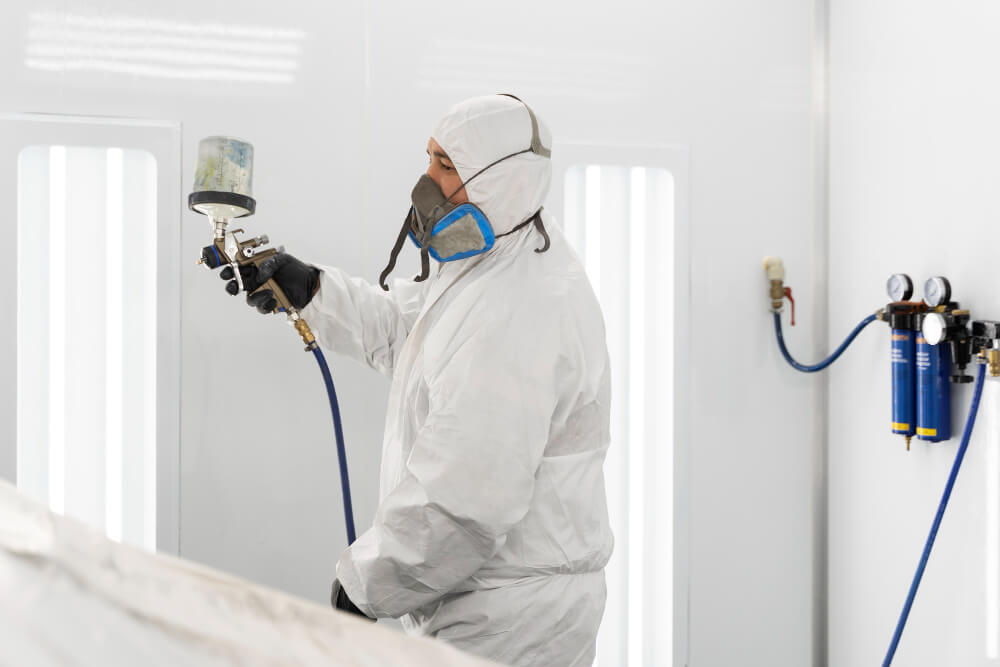Mastering the art of UPVC window spray painting has gained significant popularity in the UK as a smart and customisable way for homeowners and businesses to revitalise their properties affordably. Instead of costly replacements, UPVC spray paint offers a practical solution to achieve a refreshed look without the inconvenience of installing new windows or doors.
Read this blog to learn the essentials of being skilled in UPVC spray painting for professional-quality finishes that enhance both the attractiveness and value of the properties.
Benefits of Spray Painting UPVC
Cost-Effective Solution: UPVC spraying offers a budget-friendly alternative to costly replacements, allowing significant savings while achieving a rejuvenated appearance comparable to new installations.
Wide Range of Colors: Choose from a diverse selection of colours to personalise your property, catering to both classic and modern aesthetic preferences with ease.
Increased Property Value: This technique enhances curb appeal and market desirability, potentially increasing the resale value of the property by revitalising its exterior.
Durable Protection: The durable coatings applied during UPVC spraying are designed to endure various weather circumstances, including sunlight and rain. This weather resistance ensures integrity over the long term.
Environmentally Conscious: Promotes sustainability by extending the lifespan of existing UPVC materials and reducing landfill waste associated with full replacements.
Efficient and Convenient: Unlike lengthy replacement projects, UPVC spraying is completed efficiently and quickly, often within a matter of days. This swift turnaround minimises disruption to daily activities, allowing occupants to enjoy a refreshed property.
Enhanced Aesthetic Appeal: UPVC spraying transforms the appearance of a property, offering a refreshed look that enhances its overall aesthetic appeal. This transformation can modernise the property’s exterior, making it more attractive and inviting.
Versatile Application: UPVC spraying is not limited to windows and doors; it can also be applied to other UPVC features such as conservatories, fascia boards, and gutters. This versatility ensures a unified and consistent look.
Process of UPVC Paint Spraying
Preparation by Removing Existing Sealant
Begin by thoroughly removing any old sealant and residue from the UPVC surface. A wire brush attached to a drill can simplify this step, ensuring a clean starting point for painting.
Cleaning and Degreasing
Next, clean the UPVC frames meticulously using white spirits or methylated spirits. To enhance the longevity of the finish, a spotless sparkling surface is highly effective to adhere with paint.
Masking and Surface Preparation
Carefully mask off areas that shouldn’t be painted using brown masking paper and tape. After masking, lightly sand the UPVC surfaces with fine-grit sandpaper (around 220 or 240 grit) to promote better paint adhesion.
Application of Etching Primer
Apply a coat of etching primer designed specifically for UPVC surfaces. This primer ensures excellent adhesion, preparing the surface for the further layers of paint. It’s versatile and suitable for various exterior applications like doors and fascia.
Applying UV Filtering Lacquer
Once the primer is dry, proceed with applying subsequent layers of UV filtering polish. Before applying the next coat, allow each paint layer to dry thoroughly for approximately one hour. This step enhances durability and protects the painted surface from UV rays.
Finishing Touch with New Silicone Sealant
Complete the process by applying fresh silicone sealant around the edges of each window. Ensuring each gaps and cracks are thoroughly sealed prevents energy loss through air leakage. Proper sealing ensures efficient insulation and lowers long-term energy costs.
Choosing the Right Equipment
Here’s a list of materials and equipment required for spray painting UPVC surfaces:
- Spray paint suitable for UPVC
- Mild detergent for cleaning
- Tack cloth for dust removal
- Warm water
- Soft cloths for wiping
- Painter’s tape for masking
- 120-grit sandpaper for smoothing
- Plastic or newspaper sheets for surface safety
- Primer specifically designed for plastic surfaces
Choosing the Right Products
Choosing the right products and equipment for UPVC spray painting is critical for achieving a successful painting project. Unlike wood, UPVC is non-porous, which means it doesn’t absorb paint easily. Therefore, it’s essential to select a paint specifically designed to stick to to plastic surfaces.
- Spray paints are often recommended for UPVC doors because they can provide a smooth, uniform finish without leaving brush marks.
- Look for paints that are explicitly labelled for use on plastics or UPVC. These paints are typically acrylic or enamel-based, known for their ability to create a strong bond with plastic and withstand daily wear and exposure to the elements.
- When choosing a paint, consider opting for products that offer good adhesion and durability. These paints should be resistant to chipping and cracking, ensuring long-lasting results even with frequent use.
- Some paints come with built-in primers, simplifying the preparation process and ensuring better coverage and adhesion.
- Always follow the instructions for preparation and manufacturer’s guidelines to achieve the best outcome.
- Properly preparing the UPVC surface by cleaning and possibly sanding it lightly can also contribute to a more successful painting experience.
Training and Professional Development
Investing in the training program not only prepares professionals for UPVC spraying but also opens up opportunities in various other applications beyond traditional decorating tasks. These training courses cover the fundamentals of spray-painting techniques applicable to various surfaces. Participants can learn how to operate and adjust the equipment for different products and spraying scenarios.
These courses also emphasise transferable skills, where similar technology is utilised. While the paints may differ, participants gain knowledge of paint characteristics and application methods that apply across different surfaces and projects. Understanding these systems enables professionals to maintain steady work, regardless of any hurdle.
Guidelines and Pitfalls
To achieve a professional-looking finish and personalise your UPVC with confidence, follow the below-mentioned recommendations:
Exercise Patience: Taking your time is crucial during the spray painting process. Rushing can result in uneven coverage, drips, and an unsatisfactory final appearance.
Thorough Preparation Matters: Skipping the preparation phase is a common fault which usually happens. Paint can last longer through proper cleaning and sanding.
Moderate Application: Avoid spraying too close to the door or applying too much paint in one go. Opt for several light coats instead of one heavy application.

